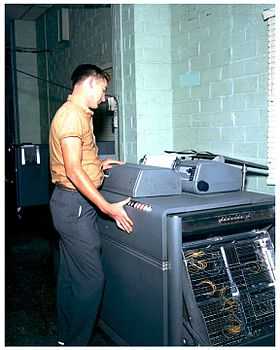IBM 407

The IBM 407 Accounting Machine, introduced in 1949, was one of a long line of IBM tabulating machines dating back to the days of Herman Hollerith. It was the central component of many unit record equipment shops. In the 1950s, the 407 was adapted as an input/output device on early computers, such as the IBM 650. Later, 407 print mechanisms were used in the IBM 1132 line printer, part of the low cost IBM 1130 computer system.
The 407 read punched cards, totaled fields on the cards, made simple decisions, printed results, and, with the aid of a summary punch, output results on punched cards that could be input to other processing steps.
The operation of the 407 was directed by the use of a removable control panel and a carriage tape. Exit hubs (impulse emitting) on the control panel are wired to entry hubs (impulse accepting) for the task to be done (see Wiring of unit record equipment). There are hubs for each card column (at both reading stations), print position, counter digit, and so on. Logic tests were also available.
Each input card was read at two successive reading stations. Thus, for example, fields in a card could be compared with the following card and, should a change be detected, say in invoice number, totals could be printed. Unlike earlier IBM tabulating machines, which had 80 read brushes at each read station, one for each column, the 407 had 960 brushes at each station, one for each possible hole in a punched card. Cards were held in position during each read cycle and the per digit pulses needed were generated using commutators, one for each column. This allowed the card to be read more than once at each station, for greater programming flexibility.[1]
For printing, the 407 used wheels, an improvement over earlier tabulators that used print bars. The wheels were stationary until a character impulse was to be printed; the wheel then rotated to one of 47 positions for printing, was driven against the plate, and then emitted an impulse (called "echo") for the character actually printed. The control panel would be wired so the echo impulses were accumulated for totals; report totals then reliably reflected what had actually been printed.
The 407 was available in a model that could read 100 cards per minute, and one reading 150 cards per minute. The former had a relay which would inhibit every third card feed cycle (giving the machine a characteristic "shrink-shrink-thunk" sound). It was possible to insert a folded card between that relay's contacts to "overclock" the slower model to the faster speed.
The IBM World Trade Corporation marketed Computing Accounting Machines (CAM), variations of either the 402 or 407 with an attached computer. CAM variations of the 407 included the 421, 444, and 447.[2]
In 1976 the IBM 407 Accounting Machine was withdrawn from marketing.[3]
See also
References
- ↑ "IBM Functional Wiring Principles". IBM. February 1966. Archived from the original on February 19, 2011.
- ↑ IBM 402, 403 and 407; IBM 421, 444, 407 and 447 for World Trade Corporation Computing Accounting Machines, IBM, undated, 11pp, A24-3475-0
- ↑ "IBM 407 Accounting Machine". IBM Archives. IBM.
- IBM (1953). IBM 407 Accounting Machine: Manual of Operation. 22-5765-7.
- IBM (1955). IBM 650 Manual of Additional Features: Magnetic Tapes, High Speed Storage, Printer. 22-6265-1.
External links
- Columbia University Computing History: The IBM 407
- IBM Archive: IBM 407 photo (in photo, the box at left side is not part of the basic 407)
- IBM Archive: IBM 407 Control Panel photo
- audio clip of IBM 407 in operation